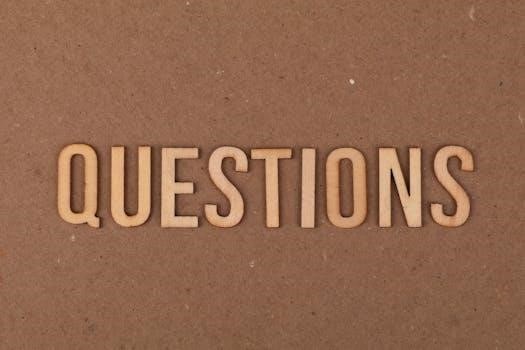
civil war questions and answers pdf

Civil War Study Guide⁚ Overview
This study guide is designed to support students in their learning about the Civil War. It covers key events, figures, and terms. A differentiated version is included to accommodate diverse learning needs. The guide can be used during or after the study of this historical period.
Purpose of Study Guides
The primary purpose of a Civil War study guide is to provide a structured framework for learning about this complex period in American history. These guides serve as a valuable tool for students, helping them organize their thoughts and focus on key concepts. They are designed to facilitate comprehension and retention of important information, such as significant events, influential figures, and crucial terminology. Study guides aid in preparation for quizzes, tests, and essays by offering a comprehensive overview of the material. They often include a variety of learning aids, such as vocabulary lists, timelines, and summaries, to cater to different learning styles. Furthermore, they can be used as a review resource, helping students reinforce their understanding of the Civil War. The guides also promote active learning by encouraging students to engage with the material critically, analyze primary sources, and connect historical events with their broader context. Essentially, a study guide acts as a roadmap, navigating students through the complexities of the Civil War and fostering a deeper understanding of its lasting impact.
Target Audience for Civil War Guides
The target audience for Civil War study guides is broad, encompassing various educational levels and learning needs. Primarily, these guides are designed for students in middle school and high school who are studying American history; They are particularly beneficial for students preparing for standardized tests or those needing extra support to grasp complex historical concepts. Additionally, these guides are valuable for undergraduate students taking introductory American history courses. Special education teachers will find them useful for adapting materials to meet diverse learning requirements. Furthermore, homeschool educators can utilize them to provide structured learning experiences for their students. Beyond formal education, history enthusiasts and individuals interested in gaining a deeper understanding of the Civil War can also benefit from these guides. The flexibility and adaptability of study guides make them a versatile resource for anyone seeking to learn more about this pivotal period in American history. Ultimately, these guides aim to cater to diverse learners, providing tailored support for effective learning and knowledge retention.

Key Concepts and Terminology
Understanding key concepts and terminology is crucial for studying the Civil War. This section includes important events, key figures, and essential vocabulary. Mastering these will improve comprehension and analysis.
Important Civil War Events
The American Civil War was marked by several pivotal events that shaped its course and outcome. The conflict began with the attack on Fort Sumter, a crucial moment that ignited the war. Following this, four states joined the Confederate States of America, further solidifying the division. The war also led to the formation of a new state. The struggle to comprehend the immense loss of life became a significant aspect of the era, as reflected in studies like “This Republic of Suffering”. Battles such as Gettysburg, Vicksburg, and Antietam are important for understanding the military strategies and turning points of the war. These events not only defined the war but also shaped the political and social landscape of the nation. Understanding the chronology and significance of these events is essential for a comprehensive understanding of the Civil War and its lasting impact. The Missouri Compromise, which dealt with slavery, also plays a crucial role in understanding the pre-war tensions that led to the conflict.
Key Figures of the Civil War
The Civil War was influenced by numerous key figures, both military and political, who played pivotal roles in shaping the conflict. Abraham Lincoln, as President of the United States, led the Union through the war, issuing the Emancipation Proclamation and guiding the nation towards reunion. Ulysses S. Grant, a prominent Union general, was instrumental in securing key victories for the North. On the Confederate side, Robert E. Lee, a highly respected military leader, commanded the Army of Northern Virginia. Jefferson Davis served as the President of the Confederate States of America. Other significant figures include William Tecumseh Sherman, whose march through the South had a devastating impact, and figures associated with political decisions. Understanding these individuals and their roles is crucial for comprehending the complexities of the war. Their leadership, strategies, and decisions shaped the course of history. The study of these figures adds depth to the understanding of the Civil War.
Vocabulary and Terms
Understanding the vocabulary and key terms associated with the Civil War is essential for a comprehensive study. Some crucial terms include “secession,” which refers to the act of states withdrawing from the Union, and “Confederacy,” denoting the states that seceded. “Emancipation Proclamation” is a vital term, signifying Lincoln’s decree freeing slaves in Confederate territories. “Fort Sumter” marks the location where the war’s first shots were fired. “Gettysburg” and “Antietam” are important battle sites, each having significant impact on the war’s trajectory. “Reconstruction” refers to the period after the war focused on rebuilding the South. Terms like “abolitionist” and “border states” also feature prominently in the Civil War narrative. “Total war” describes Sherman’s strategy to destroy the South’s infrastructure. Studying these terms helps students grasp the complexities of the era and its events. Moreover, terms related to political and military strategies also need to be covered to provide a better understanding of this period. This understanding is key to analyzing the conflict.

Study Resources and Materials
Various resources are available for studying the Civil War. These include flashcards for memorization, differentiated study guides for diverse learners, and books like “The American Civil War (America Study Guide)” available on Amazon.
Flashcards for Civil War Memorization
Flashcards are an excellent tool for memorizing key facts about the Civil War. They can help students recall important dates, events, and figures. For example, flashcards can be used to remember the start of the war, “What event officially started the Civil War?”, and the states that joined the Confederacy after the attack on Fort Sumter, “After the attack on Fort Sumter, what 4 states joined the Confederate States of America?”. They can also be helpful for learning about new states formed because of the war, “What new state forms because of the Civil War?”. Using platforms like Knowt, students can access free flashcards designed specifically for Civil War study, which helps to reinforce their understanding of the material. The use of flashcards encourages active recall, a proven method for enhancing long-term retention. They are a versatile tool that can be used individually or in groups, making them suitable for various learning styles. Flashcards can be customized to focus on specific areas where a student needs extra practice, allowing for a more personalized study approach. This method offers an engaging and efficient way to master essential information about the Civil War.
Differentiated Study Guides
Differentiated study guides are essential for catering to the diverse needs of learners when studying the Civil War. These guides acknowledge that students have varied learning styles, paces, and abilities. A differentiated approach ensures that every student can access and engage with the material effectively. For example, some students might benefit from simplified vocabulary and shorter text passages, while others may thrive with more complex readings and analysis tasks. A differentiated study guide might include various activities, such as matching exercises for vocabulary, fill-in-the-blank questions for key events, or open-ended prompts for critical thinking. This approach ensures that all students have the opportunity to master the content. A special education teacher’s perspective is invaluable in creating these materials, offering tailored strategies that support students with learning differences. By providing options and flexibility, differentiated study guides foster a more inclusive and supportive learning environment, allowing all students to succeed in their study of the Civil War. These guides are designed to make learning accessible to every student, irrespective of their individual challenges.
Civil War Study Guides on Amazon
Amazon offers a variety of Civil War study guides, catering to different learning needs and preferences. These guides range from general overviews to more focused analyses of specific aspects of the war. You can find study guides in different formats, including printed books and digital resources like Kindle versions. Some guides include maps, timelines, and primary source documents to enhance the learning experience. You can also find guides that are geared towards specific age groups or academic levels, from elementary school to college. Many of these resources have received reviews from other users, which can help you choose the guide that best suits your requirements. Some popular titles include “The American Civil War (America Study Guide)” and “Civil War Study Guide Guide and MAP ⁚ English and Spanish”. When selecting a study guide, consider factors like the author’s credentials, the scope of the material, and any additional features like practice questions or activities. Amazon provides a convenient platform to browse and purchase these resources, making it easy to access a wealth of information about the Civil War. Checking customer reviews and descriptions is crucial to ensure you choose a guide that meets your learning goals.

Educational Tools and Platforms
Numerous platforms provide resources for studying the Civil War. Teachers Pay Teachers offers original educational materials. Studocu features student-shared notes and guides. These platforms facilitate access to diverse study aids.
Teachers Pay Teachers Resources
Teachers Pay Teachers (TpT) is a valuable online marketplace offering a wide array of educational resources for educators and homeschoolers. Specifically, for the study of the Civil War, TpT provides a wealth of materials designed to enhance student learning and comprehension. These resources include comprehensive study guides that break down complex topics into manageable sections, often incorporating visual aids and interactive elements. You can find resources that focus on specific aspects of the war, such as key battles, political figures, and the social and economic impacts of the conflict. Moreover, many resources are tailored to different learning styles and grade levels. Worksheets, quizzes, and project ideas are readily available, allowing teachers to select materials that best suit their classroom needs. The platform also hosts materials created by experienced educators, ensuring high quality and curriculum alignment. Teachers can find resources that are both printable and digital, offering flexibility in how they integrate them into their lessons. In addition to study guides, TpT also offers engaging activities, primary source analysis documents, and creative writing prompts related to the Civil War.
Student Shared Lecture Notes and Guides
Student-shared lecture notes and study guides offer a unique and valuable perspective on learning about the Civil War. These resources, often found on platforms like Studocu, provide insights into how other students have approached the topic. They can include summaries of key lectures, interpretations of important readings, and personal study strategies that have proven effective. The benefit of accessing these materials is that they reflect a student’s understanding of the subject matter, which can be particularly helpful for other students who may be struggling with the same concepts. Shared notes often highlight main ideas, key vocabulary, and important dates and events, which aids in efficient review; Moreover, these resources can present information in various formats, such as bullet-point lists, mind maps, or annotated texts, catering to diverse learning preferences. Utilizing student-generated content allows for peer-to-peer learning, as students can learn from each other’s notes and study methods. The collaborative nature of these resources can create a supportive learning environment. Additionally, they provide an alternative to solely relying on textbooks and teacher-provided materials, offering a fresh perspective on the material.
Study Guides on Studocu
Studocu stands out as a valuable online platform offering a wide range of student-generated study guides, lecture notes, and summaries related to the Civil War. These resources are created by students from various educational institutions, providing diverse perspectives and approaches to understanding the conflict. The platform allows users to access materials covering different aspects of the Civil War, from key battles and figures to social and political implications. Users can find study guides specifically tailored for different courses and learning objectives, catering to various academic levels. The shared nature of these resources means that users can benefit from the work of their peers, gaining insights and study aids that might not be available elsewhere. Studocu’s interface enables easy searching and filtering of content, allowing students to efficiently locate materials relevant to their specific needs. The accessibility and variety of resources on Studocu make it a helpful tool for students looking for comprehensive support in their Civil War studies; The platform also fosters a sense of community among students, as they share knowledge and contribute to a collective learning environment. This can be particularly beneficial for those who are seeking alternative learning materials or additional support outside of the classroom.